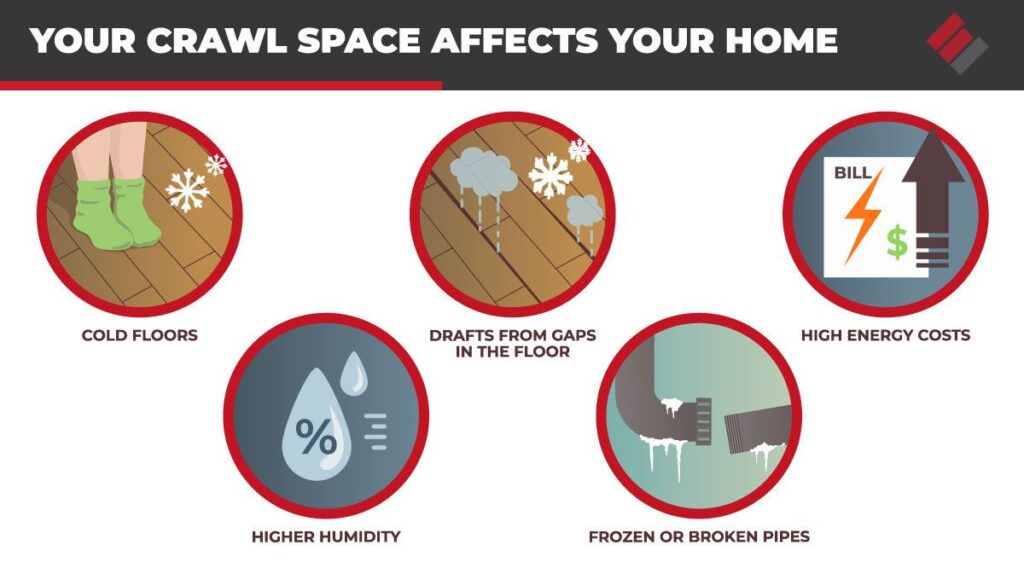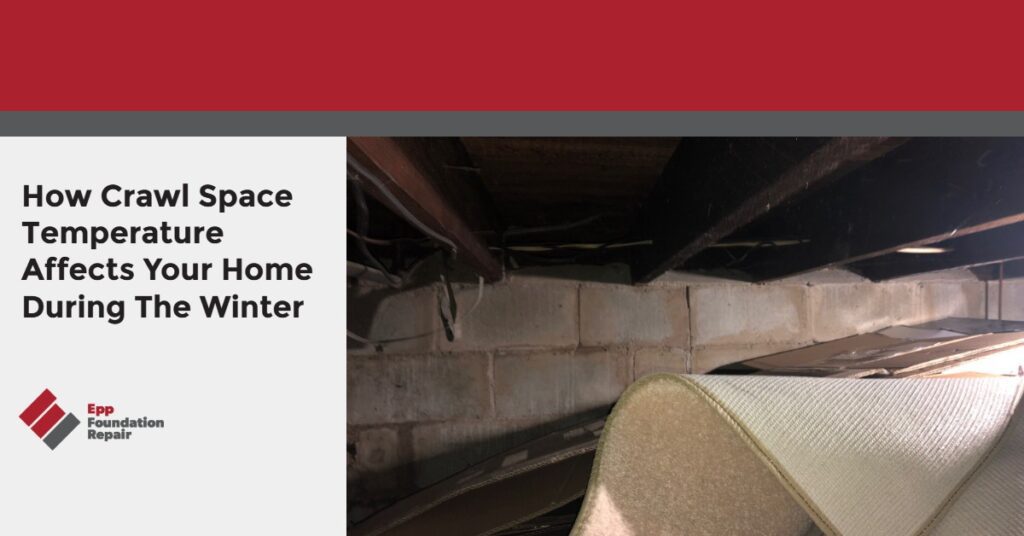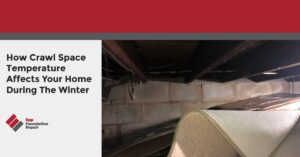Crawl space temperature during the winter affects living conditions inside your home. If you have a crawl space foundation, the crawl space is a part of your home – even though you might not think of it that way – and what goes on in the crawl space affects your comfort, health, and energy costs.
For example, a percentage of air from your home’s crawl space makes its way into your home’s living area. If the crawl space is full of mold and other allergens, the air coming up from the crawl space will be as well. If you’re breathing this air, your health could be affected.
Other ways the crawl space can affect your home’s living area include cold floors during the winter(if your crawl space is cold) and condensation on windows (if your crawl space is humid).
How crawl space temperature affects your home during the winter
Simply put, if your crawl space is cold, damp, or full of moldy air, your home’s living area will be as well.
Crawl spaces are cool because they’re usually below ground level and surrounded by cold or frozen soil. During the winter, the temperature in your crawl space is lower than the temperature inside your home because your home is heated.
Many crawl spaces – even today – aren’t insulated because people don’t think of the crawl space as being part of their home. However, air from inside the crawl space flows upward and enters your home’s living area. If the air in the crawl space is cold and damp, the air inside your home will be cold and damp. You might experience,
- Cold floors – Insulating your crawl space can help with this.
- Drafts from gaps in the floor – Again, insulation can help with this.
- Higher energy costs – A cold crawl space beneath your home is like an open window that constantly brings in cold air from outside.
- Higher humidity – While a humid crawl space will increase humidity in your home’s living area, it can also cause moisture damage to crawl space insulation, making it less effective, thereby making your home colder.
- Frozen or broken pipes – If the temperature in the crawl space drops to freezing, pipes could freeze or even burst.

Crawl space vents are often a problem. In warmer environments, they allow warm, humid air to enter the crawl space, and in colder environments, they allow cold air to enter.
Crawl space encapsulation along with insulation will make your home drier and warmer during the winter
While crawl space encapsulation along with a dehumidifier will make the air in your home cleaner and drier, adding an insulation vapor barrier as well will make your home warmer. You can even heat and air condition your crawl space for added comfort.
The crawl space encapsulation procedure
Our crawl space encapsulation service can usually be completed in 1-3 days with a crew of 2-3 and is as follows:
- A thick, polyurethane vapor barrier is laid over the floor and walls up to the ceiling. After the gaps are sealed, your crawl space is effectively isolated from the dirt floor.
- A dehumidifier is installed. Some homeowners choose to monitor humidity in the crawl space from inside their home. This enables them to check the humidity in the crawl space without crawling inside.
For an additional cost, we will also thoroughly clean the crawl space of debris. If you have pests in the crawl space, you’ll need to hire a pest removal professional.
If the homeowner wants a drain tile system installed (recommended), it will take a bit longer. However, even large encapsulation jobs don’t usually take more than a week with a crew of 2-3.
For more information, see, Thinking About A Crawl Space Vapor Barrier?
Signs you might have problems in your crawl space
If your home has a crawl space foundation and you notice any of the following, you might have one or more problems in the crawl space:
- Your home smells bad – A certain amount of air in the crawl space makes its way into your home’s living area. So, if your home smells musty, there’s probably mold in the crawl space, which means excess moisture.
- People living in the home suffer from allergies and other respiratory problems – If your crawl space is full of mold and mildew, the air inside your home will be full of allergens.
- Humidity – If your crawl space is humid, the air inside your home will be as well. If you’re wondering where the humidity is coming from, check your crawl space. There’s probably excess moisture in there.
- Condensation on windows – Moisture from the crawl space will rise into your home’s living area.
- Rotten wood in the crawl space – If there’s excess moisture in the crawl space, wood rot will eventually set in.
- Mold in crawl space – Visible mold in the crawl space is another sign of excess moisture.
- Damage caused by wood-eating insects – Pests love damp, dark crawl spaces.
Today, more and more homeowners see the crawl space as part of their home and this is why encapsulation – sometimes along with insulation – is becoming more common. If you’re concerned about your home’s crawl space temperature during the winter and you’re in our service area in Nebraska, Iowa, Kansas, or Missouri, contact us today for an estimate.







